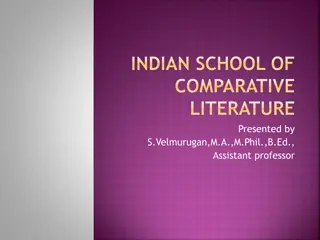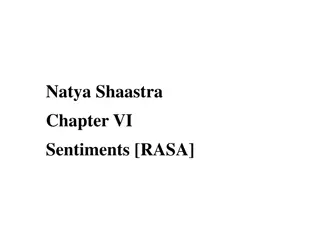Sources for the Study of Ancient Indian History: Literary and Archaeological Insights
Exploring the diverse sources available for studying Ancient Indian History up to 1206 AD, including literary works such as Brahmanical texts, epics like Ramayana and Mahabharata, Buddhist and Jaina literature, and archaeological sources like inscriptions, coins, and material artifacts. These sources provide valuable insights into the social, cultural, and religious aspects of India's past, aiding in understanding its historical evolution.
Download Presentation

Please find below an Image/Link to download the presentation.
The content on the website is provided AS IS for your information and personal use only. It may not be sold, licensed, or shared on other websites without obtaining consent from the author.If you encounter any issues during the download, it is possible that the publisher has removed the file from their server.
You are allowed to download the files provided on this website for personal or commercial use, subject to the condition that they are used lawfully. All files are the property of their respective owners.
The content on the website is provided AS IS for your information and personal use only. It may not be sold, licensed, or shared on other websites without obtaining consent from the author.
E N D
Presentation Transcript
I I- -BA HISTORY BA HISTORY Course: HISTORY OF INDIA up to 1206 ad Course: HISTORY OF INDIA up to 1206 ad Course Code: 20UHIC11L20UHVC11 Course Code: 20UHIC11L20UHVC11 Topic:- Sources for the study of Ancient Indian History T. Anas Babu Asst. Professor of History HKRH College Uthamapalayam Tamil Nadu
Contents Introduction Contents Sources to Study Ancient Indian History Various Literary Sources Conclusion
Introduction The word history is Istoria which means Knowledge/ Enquiry/ Wisdom, etc. derived from Historia or History is an enquiry in to human past based on facts This facts/evidences are available to us in the form of sources
Sources for the study of Ancient Indian History Sources for the study of Ancient Indian History Archaeological Sources Archaeological Sources Literary Sources Literary Sources Foreign Accounts Foreign Accounts 1. 1. Brahmanical Brahmanical 1. Inscriptions 2. Coins 3. Material Artifacts 4. Art and Architecture 1. 2. 3. 4. Inscriptions Coins Material Artifacts Art and Architecture 1. Greek Accounts 2. Chinese Accounts 3. Arab Accounts 1. 2. Chinese Accounts 3. Arab Accounts Greek Accounts 2. Buddhist 2. Buddhist 3. 3. Jaina Jaina 4. Classical Accounts 4. Classical Accounts
I. LITERARY SOURCES The literary sources are religious and secular in nature. Importance- It provides social, economic, cultural, religious condition of the past. Important to understand the historical evolution of the past
3. Epics: a. Ramayana- written by Valmiki - has 24000 versus b. Mahabharata- written by Veda Vyasa. - Older than Ramayana - has 100,00 versus - both provides changes of culture and beliefs. 4. Puranas: 18 in number -Vayu purana, Matsya purana, Brahma purana etc. 5. Brahmanas: the prose commentaries of Vedas - Every Veda has its own vedas 6. Aranyakas: studies done in forest 7. Sutras: Text using for the understanding of Vedas
2. Buddhist 2. Buddhist Literature Literature
3. Jaina Literature Written in Prakrit language 1. Angas 2. Upangas Life and Teachings of Lord Jaina.
4. Classical Classical Accounts Accounts
3.Ashtadhyayi written by Panini 4. Mudra Rakshasa of Visakadatta 5. Harsha Charita of Bana. 6. Rajatarangini of Kalhana etc -
II. ARCHAOLOGICAL SOURCES - Archaeological sources divided into 3 1. Inscriptions 2. Coins 3. Art and architecture 1. Inscriptions - The study of inscriptions called Epigraphy - The inscriptions provides genuine and valuable information of ancient history - It is engraved in rocks, stones, pillars, caves etc - The Ashokan edicts are the important source for Mauryan history
- The Allahabad pillar inscription of Samudra Gupta, the Hathigumpha inscription of king Karvela are the important inscriptions. Ashokan Inscription Tamil Inscription
2. Coins - Study of coins called Numismatics - Coins provides knowledge on kings, queens, gods, goddess etc. - The earliest coins are in the form of Punch marked coins - Coins are available in the form of gold, silver, copper etc. - Ancient Indian Coins
3. Art and Architecture Architecture includes monuments like Stupas, temples, palaces etc. Arts includes Sculpture and Paintings The Gandhara art and Ajanta Ellora caves are examples of Sculpture and Paintings. - - - Stupa Lion Capital of Ashoka Ajanta Cave Painting
4. Material Artifacts - Archaeological excavations - Pottery, artifacts, ornaments etc. Ancient Potteries Axe
III. FOREIGN ACCOUNTS - Foreign accounts are the accounts given by Greeks, Chinese and Arabs 1. Greek Accounts - Megasthenes wrote Indica is an important source about Maurya s - He was the Greek ambassador in the court of Chandragupta Maurya - Pliny s Natural History - Ptolomy s Geography - Periplus Eritrean Sea are some important Greek accounts
2. Chinese Accounts - Fa-Hein visited India during the time of Chandra Gupta II - Huien-Tsang called the price of pilgrims visited during the time of Harsha Vardhana wrote Si-yuki - Itsing travelled India between 671 to 695 A.D. 3. Arab Account - Tahkikul Hind of Albaruni- written in 9th century
Conclusion Innumerable sources are available for studying ancient Indian history. It throws valuable information on polity, economy, society and religion of ancient period Conclusion
Thank You Thank You























